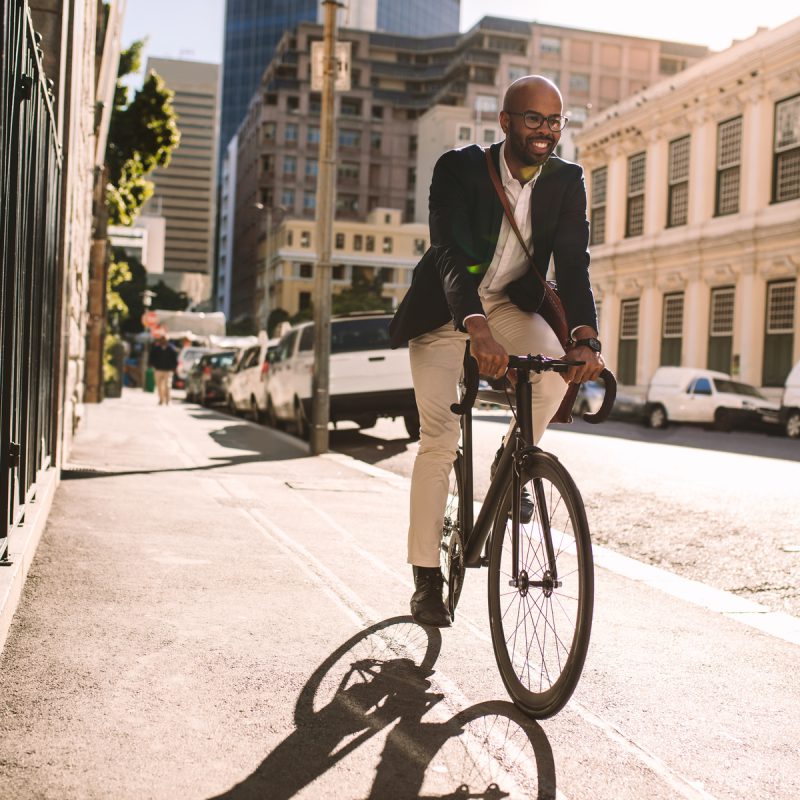Bicycling, walking, public transportation, ride-sharing, telecommuting, and working from home. These are all forms of sustainable employee transportation, or eco-friendly ways to get to work. Some are more eco-friendly than others. For example, if you’re choosing public transportation, which do you think is the most energy efficient?
Before we discuss that, let’s explore why it’s important to take a good look at sustainable employee transportation. Cars promote a sedentary lifestyle, which has been shown to cause higher rates of obesity, diabetes, and other related diseases. Motor vehicles are also responsible for up to 75% of city air pollution, and 3.7 million premature deaths in 2012 were directly linked to outdoor air pollution.
We can cut our air pollution and also increase our activity by turning to more active forms of transportation, such as walking, biking, and public transportation. This can cut the risk of obesity by as much as 17%, according to a recent study.
As an employer, you can see the numerous benefits of more eco-friendly transportation options, including less absenteeism, lower insurance costs, and overall happier, healthier employees.
So how do the various modes compare?
Public Transportation: Overall, this is one of the smartest environmentally friendly forms of transportation. Trains travel faster than cars, and buses almost match cars’ speed, so they’re carrying more people at a more efficient rate.
Rail: A recent article in Forbes lauded the modern railroad’s efficiency, noting that trains are more efficient than the Prius. Of all public options, rail is the most environmentally friendly.
Buses: Although they almost match the fuel efficiencies of rail, their ridership rates are lower. Many times, they only carry 75% of their potential load. Yet buses remain inexpensive and efficient.
Planes: While not a likely choice for day-to-day commuting, responsible companies everywhere are starting to think twice about scheduling flights for meetings and other events. Of all public transportation options, jet airliners are the hardest on the planet, and their fuel efficiency varies from airline to airline.
Personal Transportation: These modes can give you more control over your schedule, but some of them have inefficiencies that make them harmful to the environment.
Motorbikes: Motorbikes are almost as fuel efficient as buses, but be careful. The Insurance Institute for Highway Safety tells us that the fatality rate per-mile of motorcycle travel is 27 times higher than that of cars.
Cars: Cars are not very fuel efficient, despite the MPG rating. They cough up 4x more pollution than motorcycles and waste billions of gallons of fuel each year, due to idling and traffic. However, you can carpool to increase efficiency! Electric and hybrid vehicles are better, though neither touches the efficiency of rail.
Diesel and Biodiesel Cars: Diesel cars win over hybrids for long-distance driving, per a study by The Telegraph. Using oils and fats to power your biodiesel car is an efficient option too, but rail still wins.
You Power: These modes of transportation generate zero waste, but contending with weather and traffic can be an issue.
Walking: If you walk to work, you’ll have a chance to enjoy and interact with your environment, achieve better cardiovascular health, and even avoid some traffic with no environmental impact. For all its pluses, however, many times the distance makes walking infeasible.
Biking: This is often favored in large cities since it allows for better navigation through traffic. With the same or greater health benefits as walking and zero emissions, this is a great choice if the weather permits and you are safe. It’s efficient and eco-friendly!
Companies That Changed Their Worlds
Here are some companies that have encouraged more sustainable employee transportation with great success:
Google provides over 1,000 beautifully colorful Gbikes, free of charge, to its employees in Mountain View, CA. The bikes help employees move around campus, and each bike racks up about three miles a day. Its Seattle office provides standup paddleboards, its New York City office has push scooters, and there are kayaks in Sydney. The company also provides shuttle service for its San Francisco Bay Area employees, which has saved 40,000 plus metric tons of CO2 per year, or the reduction of 8,760 cars each day.
Facebook employees drive electric vehicles around their Menlo Park, CA headquarters. More than 50% of Facebook’s employees at this office also employ an alternative option to commute to work instead of driving alone. They are testing long-distance electric shuttles for employee commuting, and provide many benefits for eco-friendly commuters, including showers for cyclists. They also provide resources for ride-sharing, carpooling, and switching to public transport.
Want to Encourage More Eco-Friendly Travel?
Here are other ways to motivate employees:
- Do not promote driving. Don’t provide parking subsidies. Reduce the number of parking spaces and increase the cost of parking.
- Promote carpooling and provide incentives. Provide centralized repositories to sign up.
- Make biking and walking easier: Provide showers, bike racks, lockers, and other necessary infrastructure elements to make it easier to bike or walk to work.
- Give discounted bike-share or car-share memberships. This way, employees could bike to work but get a car when needed.
- Incentivize public transportation with discounted or pre-tax fare cards. You may qualify for tax benefits too.
- Promote online meetings when it makes sense.
Sustainable employee transportation is more than getting from point A to point B. Even with their varying degrees of efficiency, these efforts all go a long way in making the planet – and your office- a better place.

